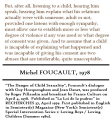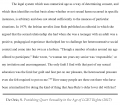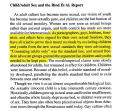One of our staff members is contributing considerably to a News Archiving service at Mu. Any well educated (Masters, PhD or above) users who wish to make comments on news sites, please contact Jim Burton directly rather than using this list, and we can work on maximising view count.
Research: Youth sexuality: Difference between revisions
| Line 9: | Line 9: | ||
The idea of "children" as "perpetrators of sexual abuse" is an American Imperialist worldview originating in the 1980s, as youth sexuality was further [[moral panic|problematized]]. By the 1990s, it had come to predominate in European countries - even formerly liberal Denmark.<ref>[https://link.springer.com/article/10.1007/s10508-022-02421-5 Leander, EM.B. Children’s Sexuality and Nudity in Discourse and Images in a Danish Education and Care Journal over 50 Years (1970–2019): The Emergence of “The Child Perpetrator of Sexual Abuse” in an International Perspective. Arch Sex Behav (2022). ]</ref> Our excerpts look mainly at studies that were not conducted under the presumption of abuse. | The idea of "children" as "perpetrators of sexual abuse" is an American Imperialist worldview originating in the 1980s, as youth sexuality was further [[moral panic|problematized]]. By the 1990s, it had come to predominate in European countries - even formerly liberal Denmark.<ref>[https://link.springer.com/article/10.1007/s10508-022-02421-5 Leander, EM.B. Children’s Sexuality and Nudity in Discourse and Images in a Danish Education and Care Journal over 50 Years (1970–2019): The Emergence of “The Child Perpetrator of Sexual Abuse” in an International Perspective. Arch Sex Behav (2022). ]</ref> Our excerpts look mainly at studies that were not conducted under the presumption of abuse. | ||
*'''McKee, Alan (2010). [https://eprints.qut.edu.au/41858/1/41858.pdf Does pornography harm young people?] ''Australian Journal of Communication'', 37(1), pp. 17-36.''' | |||
::"[...]longitudinal research and retrospective studies have consistently shown that similar-aged, consensual sexual experiences among children have no impact on adult sexual adjustment, either positive or negative (Greenwald and Leitenberg, 1989; Kilpatrick, 1992; Okami et al, 1997, p. 340). Lamb and Coakley’s research with adults who recalled childhood sexual games noted that: ‘Statistical analysis showed that these subjects did not differ from those who did not remember any childhood sexual games’ (Lamb and Coakley, 1993, p. 520). | |||
::"It is important that we distinguish between normal childhood sexual play and sexual abuse, and not simply collapse the two of them together (Lamb and Coakley, 1993). As noted above, an extensive tradition of research over many decades has established that sexual play – including looking at naked bodies, or pictures of naked bodies – can be a normal, healthy part of children’s development. But any form of coerced sexual practice – including being forced to look at pornography – can be destructive." | |||
*'''Yin Xu, Sam Norton & Qazi Rahman (2021). "[https://www.researchgate.net/publication/353849073_Adolescent_Sexual_Behavior_Patterns_Mental_Health_and_Early_Life_Adversities_in_a_British_Birth_Cohort Adolescent Sexual Behavior Patterns, Mental Health, and Early Life Adversities in a British Birth Cohort]". ''The Journal of Sex Research'', 59(1):1-12.''' | *'''Yin Xu, Sam Norton & Qazi Rahman (2021). "[https://www.researchgate.net/publication/353849073_Adolescent_Sexual_Behavior_Patterns_Mental_Health_and_Early_Life_Adversities_in_a_British_Birth_Cohort Adolescent Sexual Behavior Patterns, Mental Health, and Early Life Adversities in a British Birth Cohort]". ''The Journal of Sex Research'', 59(1):1-12.''' | ||
Revision as of 18:23, 1 March 2023
 | ||||||||||||
| Part of NewgonWiki's research project | ||||||||||||
|---|---|---|---|---|---|---|---|---|---|---|---|---|
|
| ||||||||||||
| ||||||||||||
|
| ||||||||||||
| Template: Research - This template |
Sexual activities among minors are common and do not tend to damage participants. Whilst they play an important part in learning, their diversity refutes the common myth of "childhood sexuality" and "innocent sex play".
Age-appropriate chronophilia?
It is supposed that as a child develops into an adult, his or her age-preference adjusts naturally in line with his or her age. This corresponding age attraction argument is easily dismissed as ethnocentric to Western cultures in which children are sorted into same-age peer groups. It is not supported by the evidence.
Sexual behaviour among youth
Effects and perception
The idea of "children" as "perpetrators of sexual abuse" is an American Imperialist worldview originating in the 1980s, as youth sexuality was further problematized. By the 1990s, it had come to predominate in European countries - even formerly liberal Denmark.[1] Our excerpts look mainly at studies that were not conducted under the presumption of abuse.
- McKee, Alan (2010). Does pornography harm young people? Australian Journal of Communication, 37(1), pp. 17-36.
- "[...]longitudinal research and retrospective studies have consistently shown that similar-aged, consensual sexual experiences among children have no impact on adult sexual adjustment, either positive or negative (Greenwald and Leitenberg, 1989; Kilpatrick, 1992; Okami et al, 1997, p. 340). Lamb and Coakley’s research with adults who recalled childhood sexual games noted that: ‘Statistical analysis showed that these subjects did not differ from those who did not remember any childhood sexual games’ (Lamb and Coakley, 1993, p. 520).
- "It is important that we distinguish between normal childhood sexual play and sexual abuse, and not simply collapse the two of them together (Lamb and Coakley, 1993). As noted above, an extensive tradition of research over many decades has established that sexual play – including looking at naked bodies, or pictures of naked bodies – can be a normal, healthy part of children’s development. But any form of coerced sexual practice – including being forced to look at pornography – can be destructive."
- Yin Xu, Sam Norton & Qazi Rahman (2021). "Adolescent Sexual Behavior Patterns, Mental Health, and Early Life Adversities in a British Birth Cohort". The Journal of Sex Research, 59(1):1-12.
- "This study tested adolescent sexual behavior patterns at age 14, their association with mental health at age 17 (psychological well-being, substance use, and self-harm attempts), and the influence of early life adversities upon this association. A British birth cohort (5,593 boys and 5,724 girls from the Millennium Cohort Study) was used. Latent class analysis suggested five subgroups of adolescent sexual behaviors: a “no sexual behavior” (50.74%), a “kisser” (39.92%), a “touching under clothes” (4.71%), a “genital touching” (2.64%), and an “all sexual activities” class (1.99%). Adolescents from the “kisser,” “touching under clothes,” “genital touching,” and “all sexual activities” classes reported significantly more substance use and self-harm attempts compared to adolescents from the “no sexual behavior” group. The associations became weaker after controlling for early life adversities (reducing around 4.38% to 37.35% for boys, and 9.29% to 52.56% for girls), and reduced to a smaller degree after further controlling for mental health variables at 14. The associations between sexual behaviors and psychological well-being became nonsignificant after controlling for early life adversities. Adolescents who have engaged in low-intensity sexual activities at early age may have poorer reported mental health, a pattern that is stronger for girls and early life adversity may partially explain this association."
- Nicholas, L., & Tredoux, C. (1996). "Early, late and non-participants in sexual intercourse: A profile of black South African first-year university students". International Journal for the Advancement of Counselling, 19 (2), 111–117
- NewgonWiki: In this study 267 students experienced first sexual intercourse at or before 15 years. 370 students experienced first sexual intercourse at or after 18 years. The authors report this result: "Seventy-six percent of early starters reported greater satisfaction with their first sexual intercourse than did late starters (55%) (i.e., greatly enjoying, or simply enjoying sex).“
- Larsson, I. & Svedin, C. G. (2001). "Sexual experiences in childhood: young adult's recollections," Arch Sex Behav, 31(3):263-73
- In a 2002 study of 269 Swedish students, 30% of those who had a sexual experience with a peer before the age of 13 assessed the activity as having had a positive effect on them as an adult, 66% thought it had no positive or negative effects, and 4% reported a negative effect. Except one, all of the subjects who reported a negative effect were involved in coercive activities.
- Levine, J. (1996). "A Question of Abuse," Mother Jones.
- "What's wrong with these things? "They make parents nervous," says Allie Kilpatrick, a social work professor at the University of Georgia who conducted a massive review of the literature on childhood sexual experiences, both wanted and unwanted, and administered her own 33-page questionnaire to 501 Southern women. Most of Kilpatrick's subjects had kissed and hugged, fondled and masturbated as adolescents, and more than a quarter had had vaginal intercourse. Her conclusion: "The majority of young people who experience some kind of sexual behavior find it pleasurable, without much guilt, and with no harmful consequences." A similar study of 526 New England undergraduates revealed "no differences...between sibling, nonsibling, and no-[sexual]-experience groups on a variety of adult sexual behavior and sexual adjustment measures."
- Harden, K., Mendle, J., Hill, J., Turkheimer, E., and Emery, R. (2008). "Rethinking timing of first sex and delinquency," Journal of Youth and Adolescence, 37(4), 373-385.
- "The relation between timing of first sex and later delinquency was examined using a genetically informed sample of 534 same-sex twin pairs from the National Longitudinal Study of Adolescent Health, who were assessed at three time points over a 7-year interval. [...] After controlling for these genetic and environmental confounds using a quasi-experimental design, earlier age at first sex predicted lower levels of delinquency in early adulthood. [...]
- Although the current results are contrary to embedded assumptions, they are actually consistent with previous research. Specifically, three quasi-experimental (longitudinal or behavior genetic) studies that examined whether timing of first sex influences subsequent psychosocial functioning, controlling for psychological differences that precede sexual initiation, have all failed to find adverse effects for sexual timing. [...]
- The current study suggests that there may be positive functions for early initiation of sexual activity, in that the co-twin with earlier age at first sex demonstrated lower levels of delinquency in early adulthood. This result echoes a small but important body of previous research. In one of the first pieces of sex research, Kinsey et al. (1953) concluded that premarital sexual activity resulted in minimal "psychological disturbance" and may result in healthier non-romantic relationships and greater happiness later in life. More recent research has indicated that early sexual timing is associated with popularity (Prinstein et al. 2003); high self-esteem (for a review see Goodson et al. 2006; Paul et al. 2000); positive self-concept (Pedersen et al. 2003); high levels of body pride (Lammers et al. 2000), and increasing closeness to the same-sex best friend (Billy et al. 1988). [...] In the domain of adult sexual functioning, earlier age at first sex was found to predict greater coital orgasmic capacity in adult women (Raboch and Bartak 1983) and to discriminate sexually functional versus non-functional older men (age 64 years; Vallery-Masson et al. 1981). Women reporting an earlier age at first sex demonstrate less reactivity and faster recovery (as measured by cortical response) in response to stress (Brody 2002)."
- Arreola, Sonya; Neilands, Torsten; Pollack, Lance; Paul, Jay; Catania, Joseph (2008). "Childhood Sexual Experiences and Adult Health Sequelae Among Gay and Bisexual Men: Defining Childhood Sexual Abuse," Journal of Sex Research, 45(3), pp. 246 - 252.
- "Those who had forced sex were significantly more likely to be depressed or have suicidal ideation than those who had consensual sex and those who had no sex before age 18. There was no difference between the consensual sex group and those who had no sex before age 18. The level of well-being was significantly higher for the consensual group compared with the no sex before 18 group and the forced sex group. The latter two groups did not differ from each other on well-being. [...] Interestingly, the forced sex group and the no sex group were statistically indistinguishable in their level of well-being, while the consensual sex group was significantly more likely to have a higher level of well-being than either of the other two groups. This suggests that consensual sex before 18 years of age may have a positive effect, perhaps as an adaptive milestone of adolescent sexual development." This study was inclusive of both minor-minor relations and adult-minor relations; no distinctions were made.
- Meier, A. M. (2007). "Adolescent First Sex and Subsequent Mental Health." American Journal of Sociology, 112(6), 1811–1847.
- Editor note: A more up-to date analysis of this study's findings would surely do a better job of identifying confounds of negative outcomes.
- "While some adolescents experience mental health decrements, the majority of those who had first sex did not. This finding highlights the importance of considering contingencies when investigating the effects of life events on mental health. [...] With respect to policy concerned with adolescent sexual activity, recall that welfare reform legislation’s “abstinence only” initiative suggests that nonmarital sex negatively impacts psychological well-being. This study finds mixed evidence on this assertion. On the one hand, I find support for statistically significant negative mental health effects of first sex for those in the aforementioned subgroups. On the other hand, a substantial majority of those who had sex in this sample did not experience changes in mental health. Among those who did see changes in mental health, on the individual level those changes are moderate in size—one-third to three quarters of an SD on the scales of their respective outcome. While relatively few adolescents who had sex exhibit changes in mental health, and the changes are not huge where they exist, changes of this size in these subgroups could amount to substantial shifts in population-level mental health. [...] For example, if those who had sex prior to time 1 did so in part because they had weaker norms against sex, then perhaps first sex would be less consequential for their mental health. If this is the case, the effects of first sex reported by this study may overestimate the true effects among adolescents."
- Bauserman, Robert, and Davis, Clive (1996). "Perceptions of Early Sexual Experiences and Adult Sexual Adjustment," International Journal of Sexual Health, 8(3), 37-59.
- "Results supported the hypotheses that positively evaluated early sexual experiences would be associated with greater erotophilia, more acceptance of various sexual behaviors for self and others, and greater sexual satisfaction." (From abstract.)
Prevalence and diversity
Most prevalence data is limited to parentally-observed behaviour. Surveys show decreasing rates of sexual intercourse before age 13 in America.[2]
- McKee, Alan (2010). Does pornography harm young people? Australian Journal of Communication, 37(1), pp. 17-36.
- "In a 1996 study 59% of adults surveyed said that they ‘recalled at least one sexual experience with another child during their childhood’ (Haugaard, 1996, p. 86). A 1993 retrospective study of 128 women found that 85% described ‘a childhood sexual game experience’ (Lamb and Coakley, 1993, p. 515)."
- "And in a 2002 study in Sweden 64% of girls aged 3-6 looked at other children’s genitals occasionally, sometime or often; 20% showed their genitals to children; 8% tried to look at nude pictures; 48% played doctors; 18% masturbated; 21% tried to touch other children’s genitals; and 43% touched their genitals at home (Larsson and Svedin, 2002, p.255). Meanwhile, in the same study, 65% of 3-6 year old boys looked at other children’s genitals; 50% tried to look at people undressing; 34% showed their genitals to other children; 8% tried to look at nude pictures; 37% played doctors; 28% masturbated; and 71% touched their genitals at home (Larsson and Svedin, 2002, p. 256)."
- Veraa, A. (2009). Child Sexual Abuse: The Sources of Anxiety Making and the Negative Effects. IPT Journal, vol 18.
- "Much research since then has strongly supported the notion that children are sexual beings. It has been shown that children, without prompting by adults, think sexually, may engage in a wide range of sexual activities, and enjoy them despite sanctions imposed by adults. (Langfelt, 1981; Martinson, 1981; Goldman and Goldman, 1982; 1988; Haugaard and Tilly, 1988; Okami, 1992; Paris, 1997; Sandfort, 2001; Bancroft, 2003; Denov, 2003). It has also been long known that adult/child sexual activities in other cultures, such as routine stimulation of infant’s and children’s genitals and actively instructing them as to the pleasure of sex, has produced positive rather than negative effects on children. (Ford and Beach, 1951; Yates, 1978; Herlihy, 1993; Barr, 1996; Paris, 1997). Also see Kincaid, (1998). The distaste of child sexuality in our culture seems therefore induced and not intrinsic; culturally or religiously relative, in other words."
- Martinson, Floyd M. (1973). Infant and Child Sexuality: A Sociological Perspective. The Book Mark.
- "By twelve years of age, approximately one boy in every four or five has tried at least to copulate with a female and more than ten percent of preadolescent boys experience their first ejaculation in connection with heterosexual intercourse, according to Kinsey. Ramsey reported that about one-third of his sample of middle-class boys had attempted sexual intercourse."
- Ford. C. S.. & Beach. F. A. (1951). Patterns of sexual behavior. New York: Harper & Row.
- "As long as the adult members of a society permit them to do so, immature males and females engage in practically every type of sexual behavior found in grown men and women. [p. 197] [...] After reviewing the cross-species and cross-cultural evidence, we are convinced that tendencies toward sexual behavior before maturity and even before puberty are genetically determined in many primates, including human beings."
- Reynolds, M.A., Herbenick, D. L., & Bancroft, J. (2003). The nature of childhood sexual experiences: Two studies 50 years apart. In J. Bancroft (Ed.), Sexual Development in Childhood (pp. 134-155). Indiana: Indiana University Press.
- Editor: In a 1999 study of undergraduate students, 5.2% of females and 12.8% of males reported having engaged in sex play with their peers involving genital contact before elementary school, and that 1.3% of girls and 4.0% of boys had engaged in sex play involving anal/genital insertion (with objects or fingers) or oral-genital intercourse before elementary school. By the end of elementary school, the numbers increased to 29.2% for females and 32.9% for males for genital contact and 12.3 for girls and 10.1% for boys for insertion or oral sex. Very little pressure and almost no coercion were reported.
- Thigpen, Jeffry W. (2009). "Early Sexual Behavior in a Sample of Low-Income, African American Children," Journal of Sex Research, 46(1), pp. 67-79.
- "Some recent studies of primarily White, middle-class children have expanded our knowledge of the types of sexual behavior observed in children without known or suspected histories of sexual abuse. These studies show that children engage in sexual play (Lamb & Coakley, 1993; Leitenberg, Greenwald, & Tarran, 1989; Okami, Olmstead, & Abramson, 1997); show interest in viewing the bodies of others, as well as displaying their own (Friedrich, Fisher, Broughton, Houston, & Shafran, 1998; Friedrich, Grambsch, Broughton, Kuiper, & Beilke, 1991; Phipps-Yonas, Yonas, Turner, & Kauper, 1992; Shafran, 1995); and have knowledge of sexual anatomy and function (Gordon, Schroeder, & Abrams, 1990a,b; Grocke, Smith, & Graham, 1995). Taken with the findings from earlier descriptive studies that document the occurrence of such sexual behavior as penile erections in male infants, genital manipulation and play, and masturbation (Kinsey, Pomeroy, & Martin, 1948; Kinsey, Pomeroy, Martin, & Gebhard, 1953; Moll, 1913; Spitz, 1949), non-abused children are suggested to display a wide range of sexual behavior. Behavioral differentiation by gender has been suggested, as genital manipulation and masturbatory behavior have been reported to be more common among boys (Friedrich et al., 1998; Gagnon, 1985; Rutter, 1971). Older children are suggested to be more knowledgeable than younger children about sexual behavior, pregnancy, and sexual abuse prevention (Gordon et al., 1990a), whereas hugging and kissing, self-stimulation, and exhibitionism are reported to be more common among younger children (Friedrich et al., 1991; Kinsey et al., 1948). The findings of some studies have noted an inverse relation between age and childhood sexual behavior, suggesting that the sexual behavior of children becomes covert over time (Friedrich et al., 1998; Friedrich et al., 1991; Gagnon, 1985)."
- Yates, A. (2004). "Biologic perspective on early erotic development," Child and Adolescent Psychiatric Clinics of North America, 13(3), 479-496.
- "Eighty-five percent of young university women recalled erotic games and 44% recalled erotic games that involved boys [79]. Most remembered feeling sexually aroused or excited at the time. Most of the play involved exposing or touching the genitals. Insertion of objects in the vagina and oral contact was distinctly unusual. Other studies confirmed that most young adult students recalled early sex play that they viewed in a positive light as pleasurable and exciting [40, 80 and 81]."
Early and middle childhood
- For a recent review, see Li, 2020. and perhaps combine with physical data and observations of Adrenarche as the dawn of advanced adult-like sexuality from our article on cognitive ability.
- Loretta Haroian, Ph.D. (2000, reprint). "Child Sexual Development," Electronic Journal of Human Sexuality, Volume 3, Feb. 1, 2000
- "Two year olds “love to be in the bathroom with other family members. They still like to be naked; they love to romp, flee and pursue, to taste, touch and rub.” [...] “In the later half of the third year, the child begins to feel great tension and expresses it through many compulsive patterns, such as thumb sucking, nose picking, masturbation [...] “Three-and-a-half shifts rapidly between extreme shyness and exhibitionism, all in the quest of positive attention [...] The intense need for attention, preoccupation with bodily functions, interest and curiosity about reproduction and increased ability to communicate verbally with adults can culminate in a pseudo-mature seductive posture, especially in female threes [...] It is quite common at a party of adults to see the 3-year-old daughter of the host comfortably curled up in the lap or laps of a succession of male guests capturing their attention with her interpersonal magnetism. “She may even request that her ‘new friend’ put her to bed and may hold thoughts of him and make reference to him for days or weeks after the party. This behavioral pattern is not exclusive to girls, but is somewhat more pronounced, is better tolerated in terms of gender role stereotypes and receives positive reinforcement from the involved adults [...] “The potential for sexual stimulation in this situation is obvious, and available data confirms the incidence of pedophilic genital fondling at this age [...] The sex histories of many adult men and women contain such experiences that were not traumatic or that caused little concern until the sexual activity escalated beyond looking and fondling or until the situation was discovered and responded to negatively by other adults. [...] Girls at this age are often in love with a considerably older boy or adult male [...] Most children feel that same-sex experimentation is normal and age appropriate, but that heterosexual coupling should be reserved for adulthood and reproduction.”
- Volbert, R. (1997). Sexuelles Verhalten von Kindern: Normale Entwicklung oder Indikator für sexuellen Mißbrauch?[3] In G. Amann & R. Wipplinger (Hrsg.), Sexueller Mißbrauch (S. 385-398). Tübingen: dgvt-Verlag
- [translation] “(…I)n a survey of 211 nursery nurses and kindergarten teachers of the former GDR (Bach, 1993), they stated that they had observed genital games in 75% of boys and 60% of girls aged 2 to 6 years. In a study by Klein (1993), the Erzieherinnen surveyed said that 40% of girls and 19% of boys often played on their genitals. 27% of the Erzieherinnen stated that they had noticed clear states of arousal in the children; orgasms were observed in 13% of the boys and in 17% of the girls. In a Norwegian study (Gundersen et al., 1981), 85% of the Erzieherinnen surveyed stated that they had observed masturbation in the kindergarten children. About a quarter said that it comes to orgasm in the children. In accordance with this, 81% of 91 Erzieherinnen surveyed in a study by Volbert and Zellmer (in prev.), having observed genital games in the children under their care up to 7 years of age; 43% confirmed the observation of masturbation of children and 23% reported having observed that children masturbated to orgasm".
Fetal/infant sexual capacity
Freud's theories are widely known for their references to autoerotic behaviors in infants.[4] Numerous studies have since revealed suspected epilectic seizures in infants to be masturbatory episodes.[5][6][7][8] Further investigations have gone into greater detail, including in-utero obervations:
- Giorgi, Giorgio, and Siccardi, Marco (1996). "Ultrasonographic observation of a female fetus' sexual behavior in utero," American Journal of Obstetrics and Gynecology, 175, 3(1, part 1), 753.
- "We recently observed a female fetus at 32 weeks' gestation touching the vulva with the fingers of the right hand. The caressing movements were centered primarily on the region of the clitoris. Movements stopped after 30 to 40 seconds and started again after a few minutes. Furthermore, these slight touches were repeated and were associated with short, rapid movements of pelvis and legs. After another break, in addition to this behavior, the fetus contracted the muscles of the trunk and limbs, and then clonicotonic movements of the whole body followed. Finally, she relaxed and rested.
- We observed this behavior for about 20 minutes. The mother was an active and interested witness, conversing with observers about her child's experience.
- Evidence of male fetuses' excitement reflex in utero, such as erection or ″masturbation” movements, has been previously reported.
- The current observation seems to show not only that the excitement reflex can be evoked in female fetuses at the third trimester of gestation but also that the orgasmic reflex can be elicited during intrauterine life. This would agree with the physiologic features of female sexuality: The female sexual response is separate from reproductive functions and doesn't need a full sexual maturity to be explicit."
- Thomson Salo, F. & Paul, C. (2011) Reconsidering parental sexuality, and infant sensual excitement and greed: what is lost in infant mental health without these concepts? World Association for Infant Mental Health.
- "If infants enjoy breastfeeding and enjoy their body generally, this would be a good basis for their sense of identity, self esteem and enjoyable sexuality. The British psychoanalyst, Rosine Perelberg (2007), wrote that, “The ‘right’ amount of erotism is crucial, so that it is not too much, overexciting the child, or too little, without an erotic investment for the baby, which is also so crucial for its relationship with its own body.” [...] One father asked the Maternal and Child Health Nurse if his 4-month-old son could be jealous of the parents “being intimate” – when the baby was lying on the bed beside his parents he cried loudly whenever his father touched his wife’s breasts (McWilliams, pers. comm.14.8.07). Male observers have reported 15-week-old girl babies acting flirtatiously with them. And while gender often seems relatively ignored in Infant Mental Health in the first year, yet by 6 months there is often a difference in the quality of the sensual excitement with which babies respond to adults."
- Yates, A. (2004). "Biologic perspective on early erotic development," Child and Adolescent Psychiatric Clinics of North America, 13(3), 479-496.
- "William Masters was an obstetrician before he became a sex researcher. He devised a game that he played while waiting for an infant to be born. He would bet that, if it were a boy, he could deliver the infant before the child could produce an erection. He won the game only half of the time."
- Yates, A. (1978). Sex without shame: Encouraging the child's healthy sexual development. New York: William Morrow.
- "He also noted that all girl babies lubricated vaginally in the first four to six hours of life. Infants were born ready and fully equipped. During sleep, spontaneous erections or vaginal lubrications occur every eighty to, ninety minutes throughout the entire life span. (Masters, 1975) Throughout life, sleeping sexual function remains far more reliable. While awake, our conscious anxieties take their toll.
- Masturbation culminating in climax may occur as early as the first month of life. The baby girl is the most enthusiastic and proficient. With unmistakable intent, she crosses her thighs rigidly. With a glassy stare she grunts, rubs, and flushes for a few seconds or minutes. If interrupted, she screams with annoyance. Movements cease abruptly and are followed by relaxation and deep sleep. This sequence occurs many times during the day, but only occasionally at night. The baby boy proceeds with distinct penis throbs and thrusts accompanied by convulsive contractions of the torso. After climax his erection (without ejaculation) quickly subsides and he appears calm and peaceful. Kinsey reports that one boy of eleven months had ten climaxes in an hour and that another of the same age had fourteen in thirty-eight minutes."
- Martinson, Floyd M. (1973). Infant and Child Sexuality: A Sociological Perspective. The Book Mark.
- "Before specifically discussing the affectional and sexual behavior of infants, we will more systematically and conclusively establish that infants have the somato-sensory capacity for erotic behavior. Boy babies are sometimes born with erections, and there is no reason to believe that the capacity for such marked physiological response develops any later in girls. In a study of nine male babies of ages three to twenty weeks, tumescence (penile erection) was observed at least once daily in seven of the nine. (Halverson, 1940). [...] Kinsey (1953, p. 142) reports one record of a seven-month-old infant and records of five infants under one year who were observed to masturbate. Twenty-three girls, three years or younger, appeared to reach orgasm in self stimulation. Kinsey's unpublished interview data contains notations from interviews with a small sample of two year olds and their mothers. One mother reported that her son had the habit of rubbing against a doll's head to masturbate. Another reported that her son's masturbating was deliberate, prolonged, and accompanied by an erection."
- Later article: Eroticism in Infancy and Childhood.
- Martinson, Floyd M. (1981). “The Sex Education of Young Children”, in Sex Education in the Eighties The Challenge of Healthy Sexual Evolution, ed. by Lorna Brown (Plenum Press: New York), pp. 51-82.
- “What sexual capacity, anatomical, physiological, or psychological, does the child possess that could result in sexual interest, behavior, and learning during the earliest years of life? Sexual capacities and their rehearsal are apparent in the infant long before the development of self-consciousness or erotic awakening. Knowledge of such capacity has existed for a very long time. For example, Pouillet reported research that showed the erectal capacity of infant boys almost 100 years ago, noting that all boys exhibited the faculty for erection if the edge of the foreskin of the penis was tickled with a feather (Pouillet, 1883, p. 99).
- Parents, particularly mothers, are a major source of the knowledge that boy babies commonly have spontaneous erections under a variety of conditions-a full bladder, during bathing, during sleep (Conn & Kanner, 1947, p. 339). In a study of nine male babies aged 3 to 20 weeks, Halverson (1940) reported tumescence (penile erection) at least once daily in seven of the nine. Individual responses varied from 5 to 40 erections per day. Tumescence was often accompanied by restlessness, fretting, crying, stretching, and stiffly flexing the limbs. Following detumescence, behavior was in the nature of playful activity or relaxation. In many societies genital stimulation has been used to subdue and relax infants."
Excerpt Graphic Library
The EGL on Youth Sexuality contains some useful information on this topic. Please feel free to right click, save and upload to your favored character-limited social media service.
-
Declining rates of sexual activity among youth (YRBS)
-
Various research on Teen Pregnancy correlational nonsense
-
Sexual Repression - effects on the young
-
Sexual Behavior in youth and its effects
-
Reading on child sexuality
-
Some reading on the effects of intimacy
-
Jane Rule on treatment of youth
-
NCAC: Justification for protecting children from porn has always been moral
-
Lancet Global Health: Maternal mortality by region, and across 144 countries
-
Pregnancy-Related Mortality in the USA from 1998 to 2005
Sociocultural arguments are also somewhat related:
-
Philip Jenkins on "objective" scientific terminology throughout time
-
Gilbert Herdt on the glib reductionism of "pedophile" taxon
-
Chenier - how the "pedophile" concept services mainstream society
-
Ning de Coninck-Smith[9] on the functions of pedophile-hating
-
Gayle Rubin, in Thinking Sex
-
Foucault, 1978, philosophical take on consent
-
A Percy Foundation reviewer on Chloë Taylor, and the concept of an "Ideal Victim" who is permitted to speak
-
What Foucault had to say about identity
-
Thorstad on the modern gay movement and undesirability of assimilationism[10]
-
Thorstad (same article) on similar trends in the modern gay movement
-
De Orio on pressures facing the LGBT Movement
-
De Orio on Queer Identities that don't fit the model of consent
-
De Orio with some observations about the role of Liberals in Sex Offender Panic
-
David M. Halperin warns against "Queer" essentialism in "Saint Foucault: Towards a Gay Hagiography"
-
Harris Mirkin on "consenting adults only" trope among other sexual minorities
-
David Evans on the fragile modern construct of childhood innocence and contrary examples
-
David Evans - further details the cultural underpinnings of childhood innocence
-
David Evans - more on the underpinnings of childhood innocence
-
James Kincaid: Erotic Innocence
-
Egan and Hawkes - Agency
-
Sex Offender Law Exceptionalism, and a possible reason for it
-
Kinsey is quoted on Sex Offender Exceptionalism in this meme, plus his philosophy on child trauma
-
Rene Guyon (1951) on the curious exceptionalism of sex laws
References
- ↑ Leander, EM.B. Children’s Sexuality and Nudity in Discourse and Images in a Danish Education and Care Journal over 50 Years (1970–2019): The Emergence of “The Child Perpetrator of Sexual Abuse” in an International Perspective. Arch Sex Behav (2022).
- ↑ YRBS
- ↑ Volbert, identified in Tabu Zone
- ↑ Auto-eroticism
- ↑ Wulff, C. H., Østergaard, J. R., & Storm, K. (1992). Epileptic fits or infantile masturbation? Seizure, 1(3), 199–201. doi:10.1016/1059-1311(92)90026-w
- ↑ Deda, G., Çaksen, H., Suskan, E., & Gümüs, D. (2001). Masturbation mimicking seizure in an infant. The Indian Journal of Pediatrics, 68(8), 779–781. doi:10.1007/bf02752422
- ↑ Childhood masturbation: Diagnosis of pseudoepileptic seizures in children
- ↑ Doust ZK, Shariat M, Zabandan N, Tabrizi A, Tehrani F. Diagnostic Value of the Urine Mucus Test in Childhood Masturbation among Children below 12 Years of Age: A Cross-Sectional Study from Iran. Iran J Med Sci. 2016 Jul;41(4):283-7. PMID: 27365549; PMCID: PMC4912646.
- ↑ Encyclopedia of Children and Childhood in History and Society
- ↑ Man/boy love and the American gay movement and full text, and our copy












![Ning de Coninck-Smith[9] on the functions of pedophile-hating](/wiki/images/thumb/FLCYK57XwAI5rBj.png/120px-FLCYK57XwAI5rBj.png)




![Thorstad on the modern gay movement and undesirability of assimilationism[10]](/wiki/images/thumb/20210920_033904.jpg/120px-20210920_033904.jpg)











